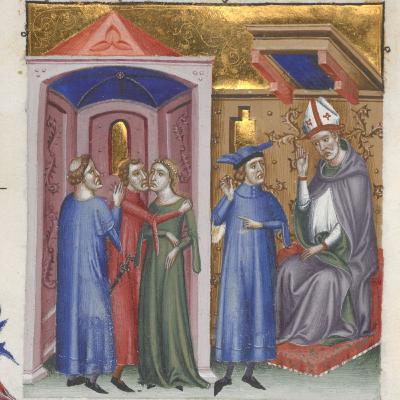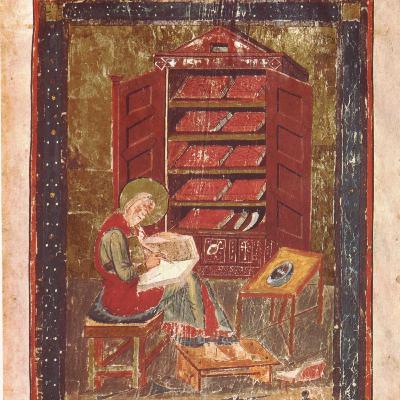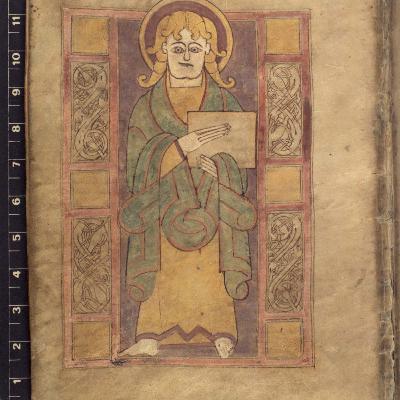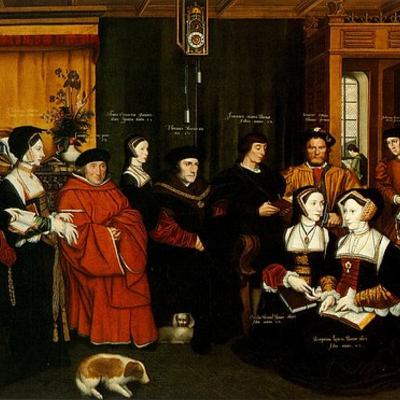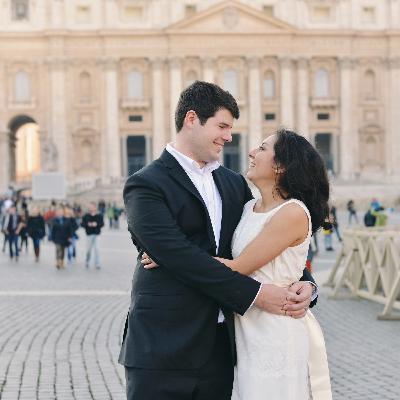Episode 7: Celibacy: From the Apostles to Lateran II
Description
*Image Credit: *"Marriage," Detail from a 14th century manuscript originating in Catalonia, Spain, available online from the British Library, Catalogue of Illuminated Manuscripts. (Public Domain)
Music Credit: *Special Thank You to Paul Spring for allowing us to use his song "Itasca" from the album Borderline EP (2014)!
Episode 7: Celibacy - Summary:
In this episode we discussed the history of celibacy in the Church, from Jewish roots in 1st century Palestine up to the Second Lateran Council in the high middle ages.
Celibacy in some form seems to exist in the apostolic and early church. So too did the ordination of married men. The debates are what the situation looked like: was celibacy required for all priests after ordination, even married ones? Did married priests separate from their wives, live Josephite marriage with them, or continue to have sexual relations with them? How did it come to the point that different parts of the Church developed different practices?
The Dead Sea Scrolls and other ancient historians show that some members of the Jewish sect known as the Essenes practiced celibacy. The Levitical priesthood also abstained from sexual relations with their wives during their service in the temple. The New Testament must be understood in this context, where sexual continence and even a more monastic form of celibate life were already known.
As we stated in the episode, we tried to carefully limit our theological discussion. But for your reference, here are some of the key Bible passages to be aware of:
• 1 Samuel 21:4-5- David and his men eat the bread of the presence, having assured Ahimelek the priest that they have "kept themselves from women."
• Luke 4:38-39 - Jesus heals Simon Peter's mother in law. This episode indicates Peter was married at some point, but it is unknown if he was a widower or still married.
• Matthew 19:12 - "For there are eunuchs who were born that way, and there are eunuchs who have been made eunuchs by others--and there are those who choose to live like eunuchs for the sake of the kingdom of heaven. The one who can accept this should accept it."
• Matthew 19:29 - "And everyone who has left houses or brothers or sisters or father or mother or wife or children or fields for my sake will receive a hundred times as much and will inherit eternal life."
• Philippians 4:3 - Paul asks his "yoke mate," to help resolve a conflict between some Christian women named in the letter to the Philippians. Some see this as a reference to Paul's wife.
• 1 Corinthians 7:8 - "Now to the unmarried and the widows I say: It is good for them to stay unmarried, as I do. But if they cannot control themselves, they should marry, for it is better to marry than to burn with passion."
• 1 Timothy 4:3 - Paul tells Timothy that prohibiting people from getting married is a sign of false teachers.
• 1 Timothy 3:1-2 - Paul tells Timothy that overseers (bishops) should be, "husband of one wife." Some church fathers see this as a negative criteria; in other words, bishops must not be husband of more than one wife, since remarrying may have suggested a lack of sexual self-discipline in their culture.
Celibacy in the early Church seems to have been connected with the Eucharistic celebration, not the ascetic ideals of monasticism which emerged a little later. This being the case, the practice may ultimately be traceable back to the Jewish roots of Christianity and is not as likely to be derived from sects that were against marriage or despised the body. Church fathers drew parallels between the Old Testament high priests, priests and Levites, and the bishops, presbyters, and deacons of the New Testament.
That said, we have to largely infer the practice of the early church in the 2nd and 3rd centuries indirectly. Based on the statements of local councils in the 4th century, as Jesuit scholar Christian Cochini explains, it seems that the likely expected practice was for priests to separate from their wives or live chastely with them following ordination. This was not practiced consistently in reality, prompting numerous councils to reiterate the discipline expected for deacons, priests and bishops. In the West, local councils such as the Council of Elvira, held around 305 in what is now Granada, Spain unequivocally called for priests to abstain from sexual relations with their wives after ordination. It was followed by other local councils in Arles and Carthage (390). The first ecumenical council, the Council of Nicaea in 325, may have touched on the issue as well in its ambiguous third canon. Some excerpts from these councils read as follows:
• Council of Elvira (circa 305), Canon 33: "It has seemed good absolutely to forbid the bishops, the priests, and the deadons, i.e. all the clerics in the service of the ministry, to have [sexual] relations with their wives and procreate children; should anyone do so, let him be excluded from the honor of the clergy." (Cochini, p. 159).
• *Council of Nicaea (325), Canon 3 *"On the women who live with clerics": "The great Council has absolutely forbidden bishops, priests, and deacons - in other words, all the members of the clergy - to have with them a sister-companion with the exception of a mother, a sister, an aunt, or, lastly, only those persons who are beyond any suspicion." (Cochini, p. 185)
• Council of Carthage (390):
"Bishop Genethlius says: As was previously said, it is fitting that the holy bishops and priests of God as well as the Levites, i.e., those who are in the service of the divine sacraments, observe perfect continence, so that they may obtain in all simplicity what they are asking from God; what the apostles taught and what antiquity itself observed, let us also endeavor to keep.
"The bishops declared unanimously: It pleases us all that bishop, priest, and deacon, guardians of purity, abstain from [conjugal intercourse] with their wives, so that those who serve at the altar may keep a perfect chastity."(Cochini, p. 5)
• 2nd Council of Arles (442-506)
Canon 2: "One cannot elevate to the priesthood a man bound by marriage unless he has first converted to continence."
Canon 3: "If a cleric, starting for order of the diaconate, dates to take with him a woman to 'console himself,' let him be rejected from communion. An exception is to be made for his grandmother [mother], sister, niece, or a wife who has converted [to continence]. If she refuses to separate [from the cleric], the woman will also be punished in the same way." (compare with Canon 3 form Nicaea). (Cochini, p. 273).
But what did the fathers of Nicaea mean? Were priests' wives included or excluded from the category of women allowed to still live with priests? One Byzantine historian said that a respected confessor named Paphnutius intervened to convince the council not to impose celibacy on married priests. Yet Norman Tanner, in his book The Councils of the Church, notes that some scholars believe the canon refers not to celibacy at all, but to the scandalous practice of some religious teachers living with their female disciples, as Paul of Samosata notoriously did (Tanner, 38).
As centuries past and the middle ages dawned, amidst widespread upheaval, differences emerged between Eastern and Western practice. One attempt at reform and compromise in recognition of the status quo in some regards for the Eastern church occurred at the Qunisext Council, also called the Council in Trullo (held in 691). Today it remains foundational for Eastern canon law. The full text of Canon 13 from Trullo reads:
• " *Canon 13: *"Since we know it to be handed down as a rule of the Roman Church that those who are deemed worthy to be advanced to the diaconate or presbyterate should promise no longer to cohabit with their wives, we, preserving the ancient rule and apostolic perfection and order, will that the lawful marriages of men who are in holy orders be from this time forward firm, by no means dissolving their union with their wives nor depriving them of their mutual intercourse at a convenient time. Wherefore, if anyone shall have been found worthy to be ordained subdeacon, or deacon, or presbyter, he is by no means to be prohibited from admittance to such a rank, even if he shall live with a lawful wife. Nor shall it be demanded of him at the time of his ordination that he promise to abstain from lawful intercourse with his wife: lest we should affect injuriously marriage constituted by God and blessed by his presence, as the Gospel says: "What God has joined together let no man put asunder;" and the Apostle says, "Marriage is honourable and the bed undefiled;" and again, "Are you bound to a wife? Seek not to be loosed." But we know, as they who assembled at Carthage (with a care for the honest life of the clergy) said, that subdeacons, who handle the Holy Mysteries, and deacons, and presbyters should abstain from their consorts according to their own course [of ministration]. So that what has been handed down through the Apostles and preserved by ancient custom, we too likewise maintain, knowing that there is a time for all things and especially for fasting and prayer. For it is meet that they who assist at the divine altar should be absolutely continent when they are handling holy things, in order that they may be able to obtain from God what they ask in sincerity.
"If therefore anyone shall have dared, contrary to the Apostolic Canons, to deprive

